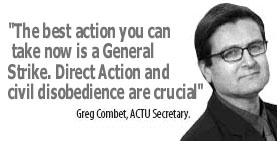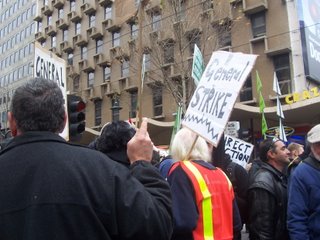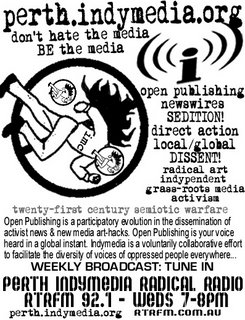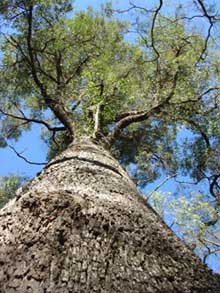November 15, 2006: WTF? One hundred thousand protestors to riot in Melbourne!

As the world's business and government gurus invade, pollute, collude and arrive to exploit and plunder the global poor, their coporate media shout these rhymes: "more than 100,000 protesters prepare to descend on Melbourne for this weekend's G20 summit, Peter Costello urged them not to be disruptive or violent..." reads the AAP text of more than a dozen news outlets. "Behave, protesters warned!" spits the headline.
Yet, action organisers expect under 10,000 people to converge on Melbourne's Grand Hyatt Hotel, where a meeting of finance ministers, business bigknobs and central bank bosses from across the planet will be cranking.
Another meeting on Saturday will include chief executives from the world's most important energy and resource companies - and nobody else.
The STOPG20 alternative convergence say the meeting is a great opportunity to challenge the G20's policies of "corporate-led globalisation, neoliberalism and hyper-capitalism onto the world's people and ecosystems - and to present alternatives."
While police say they have no specific information on any terrorist threats, they warn that protesters may occupy inner-city buildings, and they want big corporations to consider hiring extra security...
.
"Stop G20 is a collective of protest organisations targeting this weekend's forum..."
Marcus Greville, a spokesperson for the loosely aligned StopG20 crew, told the ABC "there are NO violent protests planned... We've heard that the police said that there is a likelihood that protesters will be going into buildings, going up the lifts and occupying CEOs' offices, he said. "This is just an outrageous attempt to scare people away from participating in the protest on Saturday. We want this to be a political action, and we don't want it marred by violence..."
Federal Treasurer Peter Costello said of demostrators: "There are some socialists, there are some anarchists, there are some people that want to disrupt world trade. What do you want the international footage to be of? People trying to disrupt world leaders or a warm, friendly, welcoming city?"
---
The G20 includes the Group of Seven industrial countries - the US, Germany, Japan, France, Italy, Britain and Canada - plus Argentina, Australia, Brazil, China, India, Indonesia, Mexico, Russia, Saudi Arabia, South Africa, South Korea, Turkey and the European Union.
Corporate executives from the world's most powerful oil and mining companies are also flying into Melbourne to help Treasurer Costello persuade the G20 nations to liberalise trade and investment in the resources industry.
A new lobby organisation: the "Energy and Minerals Business Council", will also hold its first meeting at the Grand Hyatt. The chief executives may are expected to address the gathering of world financial leaders. The organisation formed by BHP Billiton and Riotinto, wants to abolish free trade barriers in energy and resource markets. The group's existence has been kept secret so it does not become a focus for protest, reports the Australian. This is the first time a business group has had access to the G20.
As Mr Costello urged protesters to refrain from violence, the corporate media report that an "underground group of activists emerged from a secret conference in Melbourne yesterday to promise a day of corporate confrontation tomorrow in which office buildings in the CBD will be targeted by small groups of guerilla-style protesters, who will aim to occupy buildings." The A Space Outside group is "being monitored by police."
Some 10,000 people may attend a major central city rally from midday Saturday, prompting the total closure of some of the streets, and major streets in central Melbourne have been declared no parking zones as authorities seek to remove the risk of a car bomb.
Mr Costello said protesters must let delegates go about their business. "It's perfectly legitimate to make your point ... but the important thing is that they're non-violent and they don't try and disrupt the meeting."
Fast food and retail workers have also been urged to join the action in Melbourne this weekend, as the world's economic leaders meet.
"UNITE," the workers' union, said the summit would have implications for workers employed in major retail and fast food chains.
"This meeting is all about big business leaders discussing corporate globalisation and how best to push their agenda of cuts, privatisation and free trade on working people," said UNITE's Anthony Main.
He says the Treasurer will "proudly tell the forum about how successful the Howard Government's IR laws have been at cutting the wages of young workers".
Mr Main said the protest would be peaceful and police should "lay off the G20 protesters". "Young people and workers have the right to peacefully protest," he said. "We expect the police to respect this right and act in a professional manner on the day."
Barricades have been set up around the Grand Hyatt hotel to keep protesters at bay during the summit. The steel fencing, erected in Collins and Russell streets, is designed to separate police from demonstrators.
"We don't want fortress Hyatt. But the barriers are there for a purpose, and clearly that purpose is to maintain order," said police Assistant Commissioner Gary Jamieson. He said police had adopted new tactics after the violence that marred the World Economic Forum in 2000.
The measures include: "NEW purpose-built, 2m-wide barriers to create space between police and protesters. TEAMS of police in bright vests marked "crowd safety officer" to patrol the protesters' side of the barricades with megaphones to warn demonstrators of vehicle movements into the summit. EARLY notice to protesters about police actions so that "passive" demonstrators can move away from specific areas. POLICE to wear standard uniforms and not riot gear unless higher levels of violence erupt. EXTENSIVE training of police in the latest crowd-control tactics. GROUPS of police have also attended training sessions in Hong Kong to learn the latest tactics."
Mr Jamieson said "if protesters breach the outer perimeter they are no longer passive protesters," he said.
A StopG20 spokes, Marcus Greville, said demonstrators believed the police had no place on the protesters' side of the barricades.
"We are absolutely opposed to having misnamed crowd safety officers working within the actual demonstration itself," Mr Greville said. Mr Greville said it was impossible to say how protesters would act. He said 10,000 protesters were expected.
Police will use extensive closed-circuit cameras and their own observers to identify trouble spots. Deputy Chief Constable Patrick Shearer, from Scotland, is also in Melbourne as a consultant after his role in the 2005 Edinburgh G-8 summit, where organisers faced 250,000 protesters.
Almost 280 delegates will attend the summit to discuss mostly global finances and oil prices.
---
Some alternative events happening:
Independent Media
Nonviolent Direct Action workshops
Media of Dissent! A convergence of independent media makers
Training Workshops
G20 Empty Show
A Space Outside conference
The Breakdown Posters LAUNCH
A Space Outside conference
Infodesk at RMIT
Melbourne university Political Science student and staff gathering
The G20 - What's In It for Workers?
Guerrilla film screening
A Space Outside conference
Make Poverty History G20 Forum
Infodesk (at RMIT) & Training Workshops (at A Space Outside)
Spokescouncils
Oaxaca and Zapatista Benefit Gig
Cabaret of Dissent
Corporate Engagement Day
Give20 Seed Distribution Project
Make Poverty History concert
Spokescouncil
Meditation/Prayer Vigil
Make Poverty History Festival
Carnival Beyond Capitalism
Solidarity focus
Innoculation day!
G20 Alternative and Creating Community forum
Celebration!
Debriefings
Buy Nothing Day...
A large range of networks and affinity groups are planning activities and events to coincide with the G20, only some of which we (or anyone) is aware of due to the decentralised nature of the organising...
Read more
http://www.stopg20.org/node/115
MELBOURNE INDYMEDIA:
http://melbourne.indymedia.org/
STOPG20.ORG:
http://www.stopg20.org/
Sources:
Union calls for summit protest
Energy chiefs sneak into G20
Behave, Costello warns protesters
G-20 protest down to wire
UNITE calls for protests against G20
Melbourne prepares for G20 Forum
 A new report fuels speculation over just who or what is to blame for the so-called megafauna extinction.
A new report fuels speculation over just who or what is to blame for the so-called megafauna extinction.













